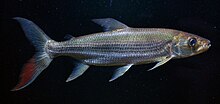
Lake Tanganyika is an African Great Lake. It is the second-oldest freshwater lake in the world, the second-largest by volume, and the second-deepest, in all cases after Lake Baikal in Siberia. It is the world's longest freshwater lake. The lake is shared among four countries—Tanzania, the Democratic Republic of the Congo (DRC), Burundi, and Zambia, with Tanzania (46%) and DRC (40%) possessing the majority of the lake. It drains into the Congo River system and ultimately into the Atlantic Ocean.
Tigerfish can refer to fish from various families, and derives from official and colloquial associations of these with the tiger. However, the primary species designated by the name "tigerfish" are African and belong to the family Alestidae.
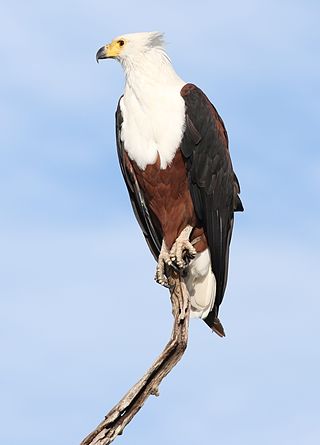
The African fish eagle or the African sea eagle is a large species of eagle found throughout sub-Saharan Africa wherever large bodies of open water with an abundant food supply occur. It is the national bird of Malawi, Namibia, Zambia, and Zimbabwe. As a result of its large range, it is known in many languages. Examples of names include: Vis Arend in Afrikaans, nkwazi in Chewa, aigle pêcheur in French, hungwe in Shona, inkwazi in isiZulu, and ntšhu in Northern Sotho. This species may resemble the bald eagle in appearance; though related, the two species occur on different continents, with the bald eagle being resident in North America.
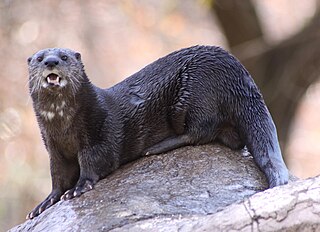
The spotted-necked otter, or speckle-throated otter, is an otter native to sub-Saharan Africa.

Hepsetus odoe, the African pike characin, is a predatory freshwater characin belonging to the family Hepsetidae. It was formerly considered that there was a single species of Hepsetus pike characin but recent studies have led to the species being split and Hepsetus odoesensu stricto is the west African representative of the group.

Salminus brasiliensis is a large, predatory characiform freshwater fish found in central and east-central South America. Despite having Salminus in its name, the dorado is not related to any species of salmon, nor to the saltwater fish also called dorado. It is very popular among recreational anglers and supports large commercial fisheries.

Hydrocynus is a genus of large characin fish in the family Alestidae commonly called "tigerfish," native to the African continent. The genus name is derived from Ancient Greek ὕδωρ ("water") + κύων ("dog"). The genus contains five species, all popularly known as "African tigerfish" for their fierce predatory behaviour and other characteristics that make them excellent game fish. Hydrocynus are normally piscivorous, but H. vittatus is proven to prey on birds in flight.

The Lake Tanganyika sardine is a species of freshwater fish in the family Dorosomatidae which was endemic to Lake Tanganyika but which has now been introduced to other lakes in Africa as a food source. It is monotypic within the genus Limnothrissa. It and the Lake Tanganyika sprat are known collectively as kapenta.
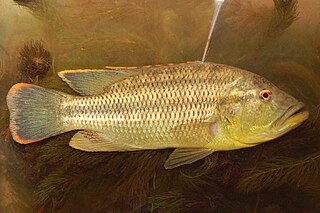
Serranochromis is a genus of relatively large, robust cichlids from freshwater habitats in mainland Southern Africa, ranging as far north as DR Congo and Tanzania, with the highest species richness in the upper Zambezi, Okavango and Congo basins. They are typically known as largemouths or, especially among fishers, breams. Serranochromis are mostly piscivores and they are important in local fisheries.

The Cornish jack, Mormyrops anguilloides, is a species of weakly electric fish in the family Mormyridae, native to quiet waters in much of Sub-Saharan Africa. The largest species in its family, the Cornish jack is a nocturnal group hunter of smaller fishes, using electricity to locate its prey and communicate with other members of its group. It is a commercial game fish valued for its size and taste.

The papermouth, also known as the silverfish is a species of ray-finned fish in the genus Enteromius.

Hydrocynus vittatus, the African tigerfish, tiervis or ngwesh is a predatory freshwater fish distributed throughout much of Africa. This fish is generally a piscivore but it has been observed leaping out of the water and catching barn swallows in flight.

Hydrocynus tanzaniae, the blue tigerfish, is a large African predatory freshwater fish.
Mormyrus longirostris, commonly referred as the eastern bottle-nosed mormyrid, is a medium-sized ray-finned fish species belonging to the family Mormyridae. It was originally described by Wilhelm Peters in Monatsberichte der Akad. Wiss. Berlin, 1852.

Hydrocynus brevis, also known as the tigerfish, Nile tigerfish or Sahelian tigerfish, is a predatory freshwater fish distributed throughout Africa.
There are two major sources of fish in Uganda; one is from aquaculture, the other from fishing in rivers and lakes. Different types of fish flourish in different water sources. The waters of Uganda contain an impressive array of fish species—over 90 in all. This count does not include the Haplochromis complex, which itself is made up of more than 200 species.
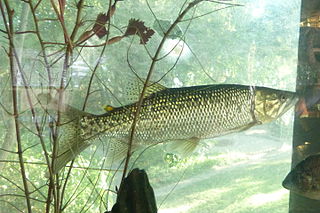
Hepsetus cuvieri, sometimes known as the African pike or Kafue pike characin, is a predatory freshwater fish found in southern Africa. This species was described in 1861 by the French naturalist Francis de Laporte de Castelnau.

Microthrissa royauxi, the royal sprat, is a species of pelagic, freshwater fish from the herring family Clupeidae which is found in the Congo River basin in west Africa. It was described in 1902 by the Belgian-British zoologist George Albert Boulenger. It is of limited importance as a food fish in subsistence fisheries and its conservation status is Least Concern.
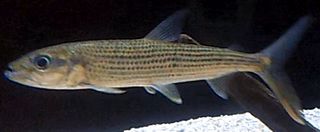
Hydrocynus forskahlii, the elongate tigerfish, is a species of predatory characin from the family Alestidae which is found in northern and western Africa.
